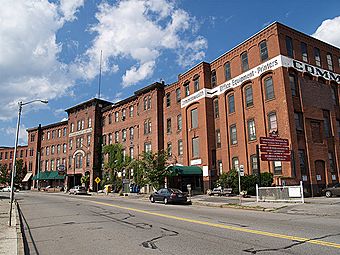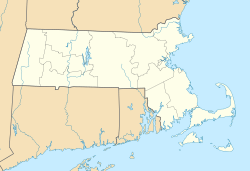Washburn and Moen North Works District facts for kids
Quick facts for kids |
|
|
Washburn and Moen North Works District
|
|
 |
|
| Location | Worcester, Massachusetts |
|---|---|
| Built | 1863 |
| Architectural style | Late Victorian |
| MPS | Worcester MRA |
| NRHP reference No. | 80000439 |
| Added to NRHP | March 5, 1980 |
The Washburn and Moen North Works District is a group of old factory buildings in Worcester, Massachusetts. This area was once home to the biggest business in Worcester during the second half of the 1800s. It shows how important manufacturing was in the city's past.
History of the Wire Works
Washburn and Moen started in 1831. They were a very creative company that made wire and other wire products. One important product was telegraph wire. This wire was used a lot as America expanded westward. It helped people communicate across long distances.
In 1874, a company called Barb Fence Company started buying a lot of wire from Washburn and Moen. They used it to make their special barbed wire. Mr. Washburn wondered why they needed so much wire. He traveled to DeKalb, Illinois, to find out.
There, he met Joseph Glidden, who owned the patent for barbed wire. A patent means he had the special right to make and sell it. Mr. Washburn convinced Glidden to sell half of his business to Washburn and Moen. Glidden agreed, but he still got money from his patent. Glidden's business partner, Isaac L. Ellwood, kept making barbed wire under his own company name.
Washburn and Moen also started making barbed wire. This product was very popular with ranchers, farmers, and railroads in the late 1800s. The company became the main producer of barbed wire. This meant they had a very large share of the market.
Developing the Factory Complex
The factory buildings, known as the Grove Street complex, were built in the 1860s and 1870s. Washburn and Moen, and later companies, used these buildings until 1943. Today, the complex is still used for making things, including special wire products. It was added to the National Register of Historic Places in 1980. This means it is an important historical site.
The factory complex is located north of downtown Worcester. It sits between Grove and Prescott Streets, just north of Faraday Street. There are thirteen brick buildings in the complex. The oldest building was built in 1863.
This oldest building, at the south end, was called the Cotton Mill. It made cotton that was used to cover crinoline wire. This wire was used to make hoop skirts, which were popular dresses at the time. When hoop skirts went out of style, the building was changed to make wire instead. It was originally three stories tall. Between 1888 and 1892, it was made into a four-story building.
Seven more buildings were built in 1869 and 1870. This was a big time of growth for the complex. The most important new buildings were the Main Mill and the Long Mill. The Main Mill is about 165 feet (50 meters) long. The Long Mill is about 196 feet (60 meters) long.
The Main Mill first had three stories and a sloped roof fourth floor. Around 1900, this fourth floor was made into a full story. The Long Mill started with two and a half stories. In 1880, it was made into a full three-story building.
More buildings were added after 1878. Existing buildings were also changed or added to, mostly before 1920. The last major addition was an extension on the north end of the Long Mill in 1916.
Joining U.S. Steel
Fred Harris Daniels was born in Worcester in 1853. He became the president of Washburn and Moen in 1906. This was after the company was bought by a much larger company called U.S. Steel. He remained president until he passed away in 1913.



